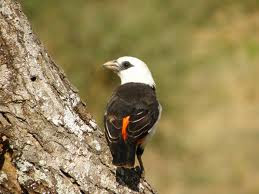Beauty Of Animal | Oxpeckers | Oxpeckers are two types of birds that are Buphagidae family. Some ornithologists regard them as a species within the family Sturnidae Buphaginae starling but it seems very distinct. Oxpeckers is endemic to the savannas of sub-Saharan Africa. Both English and scientific names arise from their habit of perching on large mammals (both wild and domesticated), such as cattle or rhinoceros, eating ticks, botfly larvae, and other parasites.According to more recent studies of phylogeny Muscicapoidea, oxpeckers is the old line of Mimidae (mockingbirds and thrashers) and starlings, but not particularly close to any of them.
Consideration of the known biogeography of these groups, the most plausible explanation seems to be descent oxpecker originated in Eastern Europe or South East Asia, like the others. This would make these types of things Buphagus such as fossil organisms, and shows that these residues elegantly can the development of the past having beaten and unique oxpeckers adaptations.The autapomorphic is endemic in sub-Saharan Africa, where he spoke in environments more open. Are absent from the driest deserts, rainforests and. And distributed only by the presence of preferred prey, certain types of ticks and tick-host of the animals. A large part of the East African species are sympatric (have overlapping distribution) and can even occur on the same host animal. Nature of the interactions between these two types is unknown.Oxpeckers feed exclusively on the emergence of large mammals. And seem to prefer some species, while others, such as Lichtenstein hartebeest or Toby will be avoided in general.
Consideration of the known biogeography of these groups, the most plausible explanation seems to be descent oxpecker originated in Eastern Europe or South East Asia, like the others. This would make these types of things Buphagus such as fossil organisms, and shows that these residues elegantly can the development of the past having beaten and unique oxpeckers adaptations.The autapomorphic is endemic in sub-Saharan Africa, where he spoke in environments more open. Are absent from the driest deserts, rainforests and. And distributed only by the presence of preferred prey, certain types of ticks and tick-host of the animals. A large part of the East African species are sympatric (have overlapping distribution) and can even occur on the same host animal. Nature of the interactions between these two types is unknown.Oxpeckers feed exclusively on the emergence of large mammals. And seem to prefer some species, while others, such as Lichtenstein hartebeest or Toby will be avoided in general.
Also avoid smaller antelope such as lechwe, deer and antelope, smaller species that is regularly used Impala, possibly due to heavy load and the tick of a social nature of these species. In many parts of the range cattle on feed now, but avoid the camels. Feed on ectoparasites, especially ticks and insects as well as injuries and flesh and blood of some of the wounds as well.Oxpecker / mammal interactions are subject to some debate and ongoing research. Was originally thought to be an example of mutualism, but recent evidence suggests that parasites may be oxpeckers instead. do not eat Oxpeckers ticks, but often the ticks that feed on the host already ungulates and there was no statistically proven a link between the lower and oxpecker load external parasites. but one study found that deer and antelope that were used by oxpeckers spent less time grooming itself refers to a decline in parasite load.
It has been observed Oxpeckers to open new wounds and strengthen existing ones in order to drink the blood of their perches. Oxpeckers also feed on the wax and dandruffs of mammals, although little is known about the benefits on the mammals, it is suspected that this is also a parasitic behavior. Some hosts oxpecker not tolerate their presence. elephants, deer and the expulsion of some actively oxpeckers when the ground. Other species, while they carry oxpeckers Find ticks on his face, as one author described as "It seems ... that the process is uncomfortable and invasive.
Scientific classificationKingdom: AnimaliaPhylum: ChordataClass: AvesOrder: PasseriformesSuborder: PasseriFamily: BuphagidaeLesson, 1828Genus: BuphagusBrisson, 1760
Find Here The Kinds Of Animals and Flora and Fauna
Animal Flora and Fauna




